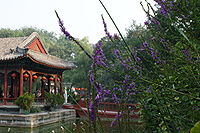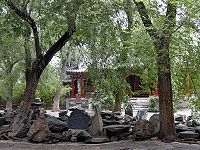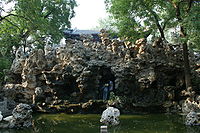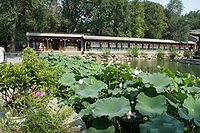
Prince Gong Mansion
Encyclopedia




Beijing
Beijing , also known as Peking , is the capital of the People's Republic of China and one of the most populous cities in the world, with a population of 19,612,368 as of 2010. The city is the country's political, cultural, and educational center, and home to the headquarters for most of China's...
, China, north of the Shichahai Lake
Shichahai
Shichahai is an historic scenic area consisting of three lakes in the north of central Beijing in China. They are located to the north-west of the Forbidden City and north-west of the Beihai Lake. Shichahai consists of the following three lakes: Qianhai , Xihai and Houhai...
. Consisting of large mansions in the typical siheyuan
Siheyuan
A siheyuan is a historical type of residence that was commonly found throughout China, most famously in Beijing. In English, siheyuan are sometimes referred to as Chinese quadrangles. The name literally means a courtyard surrounded by four buildings...
layout and gardens
Chinese garden
The Chinese garden, also known as a Chinese classical garden, is a style of landscape garden which has evolved for more than three thousand years, and which is inspired by Chinese literature, Chinese painting and Chinese philosophy...
, Prince Gong's Mansion is known as one of the most ornate and extravagant residence compounds in all of Beijing.
History
Prince Gong's Mansion was constructed in 1777 for minister He Shen (和珅) during the Qianlong-reign in the late Qing DynastyQing Dynasty
The Qing Dynasty was the last dynasty of China, ruling from 1644 to 1912 with a brief, abortive restoration in 1917. It was preceded by the Ming Dynasty and followed by the Republic of China....
. From a young age, He Shen got the trust of Emperor Qianlong, and was able to make large promotion in the imperial administration. In this way he became very wealthy.
Because of accusations of corruption, He Shen was executed and the mansion was confiscated in 1799, under the reign of Emperor Jiaqing in favor of Prince Qìng Jùnwáng (庆郡王), the 17th and youngest son of Emperor Qianlong.
In 1851, Emperor Xianfeng assigned it to his brother Prince Gong. It is his name that is currently given to the compound.
In 1921 Prince Gong's grandson offered the property as a mortgage to the Benedictine Order of the Catholic Church. The Benedictines invested significant resources into restoring the badly dilapidated mansion for use as a university. It was then known as Furen Catholic University
Fu Jen Catholic University
Fu Jen Catholic University is a co-educational Catholic university located in Xinzhuang District, New Taipei City, Republic of China...
until the monks were evicted from China in 1951. The former Fu Jen campus was converted into Beijing Normal University, and then the Chinese Music Academy.
During the Cultural Revolution
Cultural Revolution
The Great Proletarian Cultural Revolution, commonly known as the Cultural Revolution , was a socio-political movement that took place in the People's Republic of China from 1966 through 1976...
the building was used by the Beijing Air Conditioning Factory.
In the 1980s it had a new revival. In 1982 it has been declared as one of the Chinese National Cultural Heritages in Beijing.
Since November 1996 the buildings and the gardens have become a new publicly open scenic spot for tourists.
Structure of the compound
Prince Gong's Mansion is one of the most exquisite and best-preserved royal mansions in Beijing and used to house several families, and has a total area of 60,000 square metres.The mansion buildings are located in the south; the gardens are in the north.
The buildings include several siheyuan
Siheyuan
A siheyuan is a historical type of residence that was commonly found throughout China, most famously in Beijing. In English, siheyuan are sometimes referred to as Chinese quadrangles. The name literally means a courtyard surrounded by four buildings...
courtyards, two story buildings, and even a grand Peking opera
Beijing opera
Peking opera or Beijing opera is a form of traditional Chinese theatre which combines music, vocal performance, mime, dance and acrobatics. It arose in the late 18th century and became fully developed and recognized by the mid-19th century. The form was extremely popular in the Qing Dynasty court...
house.
In addition to the mansion, there is a 28,000-square-metre garden, with twenty scenic spots, pavilions, artificial hills including rock originating from the Taihu Lake in Jiangsu
Jiangsu
' is a province of the People's Republic of China, located along the east coast of the country. The name comes from jiang, short for the city of Jiangning , and su, for the city of Suzhou. The abbreviation for this province is "苏" , the second character of its name...
, and ponds.
There is a 8-meter-long stele
Stele
A stele , also stela , is a stone or wooden slab, generally taller than it is wide, erected for funerals or commemorative purposes, most usually decorated with the names and titles of the deceased or living — inscribed, carved in relief , or painted onto the slab...
which has the character 福 (fú: good fortune), carved based on the calligraphy of Emperor Kangxi on it.
Restoration works and future
Since 2005 the mansion has undergone renovation worth 200 million yuanChinese yuan
The yuan is the base unit of a number of modern Chinese currencies. The yuan is the primary unit of account of the Renminbi.A yuán is also known colloquially as a kuài . One yuán is divided into 10 jiǎo or colloquially máo...
. In November 2006 restoration works started on the buildings. The mansion reopened as the Gong Wang Fu museum on August 24, 2008. It will display royal families' lives and aspects of the Qing Dynasty.
The Peking opera house inside the royal mansion not only stages Beijing opera
Beijing opera
Peking opera or Beijing opera is a form of traditional Chinese theatre which combines music, vocal performance, mime, dance and acrobatics. It arose in the late 18th century and became fully developed and recognized by the mid-19th century. The form was extremely popular in the Qing Dynasty court...
performances, but also other prominent forms of Chinese opera
Chinese opera
Chinese opera is a popular form of drama and musical theatre in China with roots going back as far as the third century CE...
as well. In August 2008, the Kunqu
Kunqu
Kunqu , also known as Kunju , Kun opera or Kunqu Opera, is one of the oldest extant forms of Chinese opera. It evolved from the Kunshan melody, and dominated Chinese theatre from the 16th to the 18th centuries. The style originated in the Wu cultural area...
performance group from the prestigious "Jiangsu Kunqu House
Jiangsu Province Kunqu Theatre
Jiangsu Province Kun Opera is a professional company, based in Nanjing, engaged in Kunqu research, production and performance.Six members of the opera have won the Plum Blossom Prize: Zhang Jiqing, Shi Xiaomei, Hu Jinfang, Huang Xiaowu and Zhang Jidie...
" performed at the Prince Gong Mansion for a week's run with their program Floating Dreams. Among the celebrity audiences who were at the opening including leading American soprano Renée Fleming
Renée Fleming
Renée Fleming is an American soprano specializing in opera and lieder. Fleming has a full lyric soprano voice.Fleming has performed coloratura, lyric, and lighter spinto soprano repertoires. She has sung roles in Italian, German, French, Czech, and Russian, aside from her native English. She also...
.

